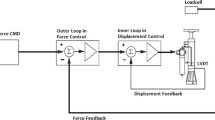Abstract
Model-based feedforward–feedback tracking control has been shown as one of the most effective methods for real-time hybrid simulation (RTHS). This approach assumes that the servo-hydraulic system is a linear time-invariant model. However, the servo-control closed-loop is intrinsically nonlinear and time-variant, particularly when one considers the nonlinear nature of typical experimental components (e.g., magnetorheological dampers). In this paper, an adaptive control scheme applying on a model-based feedforward–feedback controller is proposed to accommodate specimen nonlinearity and improve the tracking performance of the actuator, and thus, the accuracy of RTHS. This adaptive strategy is used to estimate the system parameters for the feedforward controller online during a test. The robust stability of this adaptive controller is provided by introducing Routh’s stability criteria and applying a parameter projection algorithm. The tracking performance of the proposed control scheme is analytically evaluated and experimentally investigated using a broadband displacement command, and the results indicates better tracking performance for the servo-hydraulic system can be attained. Subsequently, RTHS of a nine-story shear building controlled by a full-scale magnetorheological damper is conducted to verify the efficacy of the proposed control method. Experimental results are presented for the semi-actively controlled building subjected to two historical earthquakes. RTHS using the adaptive feedforward–feedback control scheme is demonstrated to be effective for structural performance assessment.











Similar content being viewed by others
References
Ahmadizadeh M, Mosqueda G, Reinhorn AM (2008) Compensation of actuator delay and dynamics for real-time hybrid structural simulation. Earthq Eng Struct Dynam 37(1):21–42
Carrion JE, Spencer BF Jr (2007) Model-based strategies for real-time hybrid testing, Newmark Structural Engineering Laboratory Report Series. University of Illinois at Urbana-Champaign, Urbana No.6
Chen C (2007) Development and numerical simulation of hybrid effective force testing method. Ph.D. Dissertation, Department of Civil and Environmental Engineering, Lehigh University, Bethlehem, PA
Chen C, Ricles JM (2010) Tracking error-based servohydraulic actuator adaptive compensation for real-time hybrid simulation. J Struct Eng (ASCE) 136:432–440
Chen PC, Tsai KC (2013) Dual compensation strategy for real-time hybrid testing. Earthq Eng Struct Dynam 42(1):1–23
Darby AP, Williams MS, Blakeborough A (2002) Stability delay compensation for real-time substructure testing. J Eng Mech (ASCE) 128(12):1276–1284
Dyke SJ, Spencer BF Jr, Sain MK, Carlson JD (1996) Modeling and control of magnetorheological dampers for seismic response reduction. Smart Mater Struct 5(5):565–575
Horiuchi T, Inoue M, Konno T, Namita Y (1999) Real-time hybrid experimental system with actuator delay compensation and its application to a piping system with energy absorber. Earthq Eng Struct Dynam 28(10):1121–1141
Ioannou PA, Fidan Barış (2006) Adaptive control tutorial. Society for Industrial and Applied Mathematics, Philadelphia
Jung RY, Shing PB, Stauffer E, Thoen B (2007) Performance of a real-time pseudodynamic test system considering nonlinear structural response. Earthq Eng Struct Dynam 36(12):1785–1809
Kim SB, Spencer BF Jr, Yun CB (2005) Frequency domain identification of multi-input, multi-output systems considering physical relationships between measured variables. J Eng Mech 131(5):461–473
Mercan O, Ricles JM (2007) Stability and accuracy analysis of outer loop dynamics in real-time pseudodynamic testing of SDOF systems. Earthq Eng Struct Dynam 36(11):1523–1543
Nakashima M, Masaoka N (1999) Real-time on-line test for MDOF systems. Earthq Eng Struct Dynam 28(4):393–420
Ohtori Y, Christenson RE, Spencer BF Jr (1994) Benchmark control problems for seismically excited nonlinear buildings. J Eng Mech 130(4):366–385
Phillips BM, Spencer BF Jr (2012) Model-Based framework for real-time dynamic structural performance evaluation, Newmark Structural Engineering Laboratory Report Series. University of Illinois at Urbana-Champaign, Urbana No. 31
Phillips BM, Spencer BF Jr (2011) Model-based feedforward-feedback tracking control for real-time hybrid simulation, Newmark Structural Engineering Laboratory Report Series. University of Illinois at Urbana-Champaign, Urbana No. 28
Yang G, Spencer BF Jr, Carlson JD, Sain MK (2002) Large-Scale MR fluid dampers: modeling and dynamic performance considerations. Eng Struct 24(3):309–323
Zhao J, French C, Shield C, Posbergh T (2003) Considerations for the development of real-time dynamic testing using servo-hydraulic actuation. Earthq Eng Struct Dynam 32(11):1773–1794
Acknowledgments
The research of this study was supported in part by the Graduate Students Study Abroad Program NSC-101-2917-I-002-005 and NSC-095-SAF-I-564-036-TMS sponsored by National Science Council in Taiwan. The authors would like to acknowledge the National Science Foundation’s support under grant CMMI-1011534, as well as Dr. Richard E. Christenson for the use of the 200 kN MR damper.
Author information
Authors and Affiliations
Corresponding author
Rights and permissions
About this article
Cite this article
Chen, PC., Chang, CM., Spencer, B.F. et al. Adaptive model-based tracking control for real-time hybrid simulation. Bull Earthquake Eng 13, 1633–1653 (2015). https://doi.org/10.1007/s10518-014-9681-2
Received:
Accepted:
Published:
Issue Date:
DOI: https://doi.org/10.1007/s10518-014-9681-2




